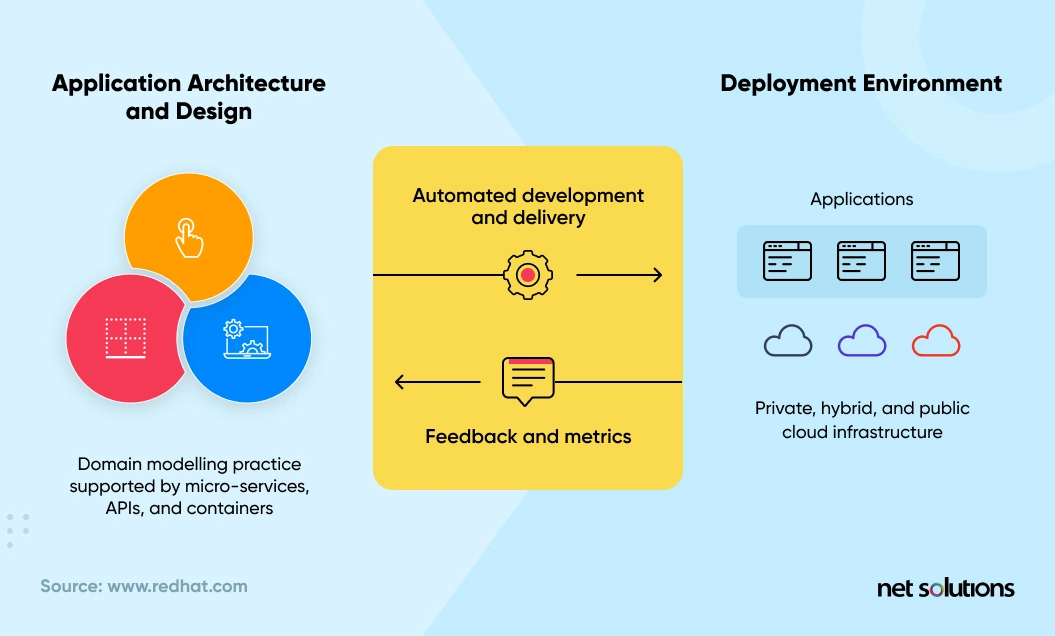Cloud-native development is an approach to developing, building, and shipping applications in a cloud environment. This guide will outline the four pillars of cloud-native development and how to start.
Organizations must change how they design, build, and use applications to succeed in today’s ever-changing digital landscape. Cloud-native application development is an approach to designing, constructing, and operating an application with cloud computing environments for new products and app modernization efforts.
Today, over 75% of companies focus on developing cloud-native applications. The Enterprise Strategy Group suggests that the push to cloud-native architecture is accelerating. While only 7% of organizations run 75% of their production applications on a cloud-native, microservices architecture, that figure jumps to 30% within 24 months.
In this blog, we will explore everything related to cloud-native application development: what are cloud-native app development, the benefits of cloud-native applications, cloud-native architecture, cloud-native deployment, and other considerations for cloud-native product development.
What is Cloud-Native Development?
What is cloud-native, and how does it apply to applications and development? A cloud-native app is an application (software, product) that runs in a cloud environment, whether public, private, or hybrid. Cloud-native application development (or cloud-based product development) is this modern approach to building applications for the cloud – taking advantage of the cloud’s flexibility, scalability, resilience, and security. It is central to new architecture models such as MACH.
Characteristics of cloud-native application development
All servers, databases, and software will reside in the cloud for an application to be considered cloud-native. The opposite of cloud-native would be on-premise – an application hosted and operating in a physical location of the business.
Cloud-native development is an approach to building applications for the cloud or re-architecting them through application modernization services. It uses key pillars (addressed below) to build apps quickly, focusing on best-in-breed solutions and resiliency.

Cloud-Native vs. Cloud-Based vs. Cloud-Agnostic
These three terms sound the same but have nuanced meanings.
- A cloud-based application was initially built for on-premise servers but has been re-constructed to run on the cloud.
- A cloud-native application is built to run on the cloud and with cloud-based technologies, but it relies on the features or tools of a specific cloud platform (e.g., Azure or AWS, or Google Cloud ), so it can only be used on that one platform (unless re-architected to work elsewhere).
- A cloud-agnostic application does not rely on the features of a specific cloud platform – it can work on any cloud platform, allowing you to move it from service to service without issues. Still, building features typically built into cloud platforms requires more up-front costs.
Key Pillars of Cloud-native Development

Cloud-native application development has four key pillars or principles:
-
Microservices
The application relies on microservices: discrete, reusable components or modules that each have a single responsibility within the overall app, with each service built around a business capability, defining boundaries around each microservice to improve the resiliency of the overall app.
-
Continuous Delivery
Continuous delivery (CD) is a product development process that prioritizes automatic testing, fixing, and deploying new code to a live environment to ensure a bug-free, efficient, and reliable product.
-
Containerization
Containerization is a software deployment process that bundles the code of an application with all its files and libraries – a process called virtualization – so that they can run in isolated spaces or containers. Common containerization tools include Docker and Kubernetes.
-
DevOps
DevOps is a term that signifies close collaboration between development and operations teams, a series of practices, culture and tools to increase software development velocity.
Examples
There are many examples of cloud-native applications, with Gartner suggesting that 95% of digital workloads will be deployed on cloud-native applications by 2025. Many eCommerce stores are cloud-native applications, relying on microservices to support search, payment, or customer chat features – each can be swapped or scaled as needed.
Benefits of Cloud-Native Development

- Improved scalability It is easy to scale up or down to meet changing needs. One part can scale up independently of the rest with microservices, providing a cost-effective solution.
- Increased reliability Cloud-native applications rely on microservices, which are independent of each other. If one part goes down or is being updated, this does not impact the rest of the system, increasing reliability. Further, the modular organization helps improve the performance of the whole system.
- Better resource utilization The ability to scale only what is needed eliminates unnecessary spending on infrastructure. Further, utilizing microservices and inherent tools of a cloud platform saves time and money.
- Faster time to market Since a cloud-native application takes advantage of tools and services built into cloud platforms and third-party microservices, it can be built more rapidly.
- Improved security Cloud-based solutions provide a high level of security features and benefit from the protections of public cloud providers (AWS, Azure, Google Cloud), each of which bakes security into their environments, has large teams, and offers additional security services and features (e.g., localized data storage, access & monitoring). However, you must still protect your data, infrastructure, and apps.
Challenges of Cloud-native Development

- Complexity of microservices The sheer number of microservices requires more oversight to maintain each service and code base, and all the pieces work together well. There is an increased demand for strong integrators and strong APIs to support this.
- Integration of microservices Each microservice must be assessed and tested individually and cohesively to ensure they meet business objectives. The number of microservices can increase the need for testing, which can become challenging.
- Managing the state in a microservices environment As applications grow in size and complexity, relying on more independent parts or running asynchronous operations, managing a shared global state becomes more challenging. Many state management libraries can help, but the most significant advice is to avoid using the international state for everything – instead, use the right tool for the job.
- Testing and validating microservices It is important to bake in testing that looks at each microservice in the architecture and integration tests for features composed of many parts to ensure everything is running as expected (and securely) and that the application has no side effects.
- Lock-in Cloud-native development does require a commitment to a single platform, which can be a source of vendor lock-in, though the flexibility offered by microservices counteract this.
Implementing Cloud-Native Development
- Assessment of existing systems Product development can focus on how to build cloud-native apps from the ground up; many organizations are re-architecting existing apps to be cloud-native. Rather than “lifting and shifting” (essentially, cloud-enabling), organizations take the essence of an app but build it from the ground up to be cloud-native, breaking up existing monolithic applications into microservice components.
- Designing a cloud-native architecture There are many decisions to be made at the architecture level: which cloud model to use (public, private, hybrid), which cloud provider, which microservices exist vs. which need to be built, and all the supporting technologies (e.g., containers) that will be leveraged. Two beneficial architecture models can assist here: MACH architecture and composable architecture.
- Decomposing existing systems Composable technologies have modular components where assembly and reassembly are easy, the key to supporting composable architecture. Where existing systems are present, “decomposing” is breaking up a monolithic system into its parts – understanding each in terms of modules or packaged business capabilities.
- Building Microservices Where microservices are not available as third-party integrations, they can be built from the ground up, also serving as the basis for future products or iterations. Leverage containerization services to encapsulate the application services.
- Integrating microservices into a cohesive system Once each microservice is selected or built, it relies on an application programming interface (API) to become the glue – the communicator – between each piece. A strong API management platform can assist here, as can a service mesh, an infrastructure layer built into the app to document how everything works together. Further, continuous integration and continuous delivery (CI/CD) processes ensure faster build, delivery, and deployment cycles and take advantage of automation in testing to ensure the integrity of the parts and system. If your organization needs strong integrators on the team, seek experienced help.
- Testing and validation Any architecture is only as strong as it is tested to be – and thankfully, the lack of dependencies in cloud-native applications lends itself well to testing, often leveraging automation.

How Net Solutions can help
Organizations are shifting to cloud-native applications to gain flexibility and agility to meet market demand and optimize collaboration across DevOps teams. These applications and practices will remain important as organizations continue their digital transformations.
Net Solutions teams understand that cloud technology answers today’s critical business challenges. We provide full-scope services, helping you design and build cloud-native apps that allow you to create efficiency, scalability, security, cost savings and many other benefits. To find out more, reach out.
Frequently Asked Questions
1. What is cloud-native app development?
Cloud-native application is designing, building, and deploying an application to operate in a public, private, or hybrid cloud environment.
2. What are the key concepts in developing cloud-native applications?
The cloud-native architecture includes microservices, DevOps, containerization, and continuous delivery to create apps that run in a single cloud environment.
3. Is DevOps a cloud-native application?
DevOps is one of the four key pillars in cloud-native application development.
4.What is a common cloud native technologies list?
Commonly used cloud-native technologies include APIs, containerization tools (Kubernetes, Docker, Prometheus), cloud platforms (AWS, Google Cloud, Azure), and other services to manage these relationships, such as Istio (a service mesh for microservices).


